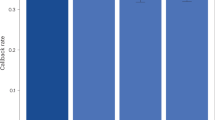Abstract
The effects of pregnancy on hiring decisions during employment interviews are examined in a United States sample of 210 undergraduate business school students at a Midwestern university. A pregnant applicant was compared to a non-pregnant applicant with identical credentials and interview performance to explore any differences in interviewer ratings of qualifications and hiring by having participants view videotaped interviews. Results show that in spite of being viewed as equally qualified and well-suited for the job, the pregnant applicant received significantly lower hiring recommendation ratings. The pregnant applicant was also rated as more likely to need time off, miss work and quit compared to the non-pregnant applicant, indicating a concern about absenteeism regarding the pregnant applicant.
Similar content being viewed by others
References
Armour, S. (February, 2005). Pregnant workers report growing discrimination. USA Today. Retrieved April 10, 2006, from http://www.usatoday.com/money/workplace/2005-02-16-pregnancy-bias-usat_x.htm.
Cleveland, J. N., Stockdale, M., & Murphy, K. R. (2000). Women and Men in Organizations: Sex and Gender Issues at Work. New Jersey: Lawrence Erlbaum Associates, Inc.
Corse, S. J. (1990). Pregnant managers and their subordinates: The effects of gender expectations on hierarchical relationships. The Journal of Applied Behavioral Science, 26, 24–47.
DeNicolis Bragger, J., Kutcher, E., Morgan, J., & Firth, P. (2002). The effects of the structured interview on reducing biases against pregnant job applicants. Sex Roles, 46, 215–226.
Dipboye, R. L. (1992). Selection Interviews: Process Perspectives. Cincinnati: South-Western Publishing Co.
Eagly, A. H., & Karau, S. J. (2002). Role congruity theory of prejudice toward female leaders. Psychological Review, 109, 573–598.
Faul, F., & Erdfedler, E. (1992). GPOWER: A priori, post-hoc, and compromise power analyses for MS-DOS (computer programme). Bonn, FRG: Bonn University, Dep. of Psychology. (http:// www. Psychologie.uni-trier.de:8000/projects/gpower.html).
Franco, K., Evans, C. L., Best, A. P., Zrull, J. P., & Pizza, G. A. (1983). Conflicts associated with physicians’ pregnancies. American Journal of Psychiatry, 140, 902–904.
Gueutal, H. G., & Taylor, E. M. (1991). Employee pregnancy: The impact on organizations, pregnant employees and co-workers. Journal of Business and Psychology, 5, 459–476.
Halpert, J. A., & Hickman Burg, J. (1997). Mixed messages: Co-worker responses to the pregnant employee. Journal of Business and Psychology, 12, 241–253.
Halpert, J. A., Wilson, M. L., & Hickman, J. L. (1993). Pregnancy as a source of bias in performance appraisals. Journal of Organizational Behavior, 14, 649–663.
Hammond, K. R. (1996). Human Judgment and Social Policy: Irreducible Uncertainty, Inevitable Error, Unavoidable Injustice. New York: Oxford University Press.
Hebl, M. R., & Kleck, R. E. (2002). Acknowledging one’s stigma in the interview setting: Effective strategy or liability? Journal of Applied Social Psychology, 32, 223–249.
Hebl, M. R., & Skorinko, J. L. (2005). Acknowledging one’s physical disability in the interview: Does “when” make a difference? Journal of Applied Social Psychology, 35, 1–17.
Heilman, M. E. (1983). Sex bias in work settings: The lack of fit model. Research in Organizational Behavior, 5, 269–298.
Hitt, E. R., & Barr, S. H. (1989). Managerical selection decision models: Examination of configural cue processing. Journal of Applied Psychology, 74, 53–61.
Huvelle, N. F., Budoff, M., & Arnholz, D. (1984). To tell or not to tell: Disability disclosure and the job interview. Journal of Visual Impairment & Blindness, 78, 241–244.
Kacmar, K. M., Wayne, S. J., & Ratcliff, S. H. (1994). An examination of automatic versus controlled information processing in the employment interview: The case of minority applicants. Sex Roles, 30, 809–828.
Kazama, S. M., & Hebl, M. R. (2003, April). Assessing pregnancy in hiring situations: The role of formal and interpersonal discrimination. Paper presented at 18th annual SIOP conference, Orlando, Fl.
Klerman, J. A., & Leibowitz, A. (1999). Job continuity among new mothers. Demography, 36, 145–155.
Macan, T. H., Detjen, J. B., & Dickey, K. L. (1994). Measures of job perceptions: Gender and age of current incumbents, suitability, and job attributes. Sex Roles, 30, 55–67.
Macan, T. H., & Dipboye, R. L. (1990). The relationship of interviewers’ preinterview impressions to selection and recruitment outcomes. Personnel Psychology, 43, 745–768.
O’Connel, M. (December, 2001). New census bureau analysis indicates women making longer-term commitments to workplace. U.S. Census Bureau News. Retrieved April 3, 2006, from http://www.census.gov/Press-Release/www/releases/archives/fertility/000319.html.
Pregnancy discrimination. The U.S. Equal Employment Opportunity Commission. Retrieved April 10, 2006, from http://www.eeoc.gov/types/pregnancy.html.
Schmitt, N. (1976). Social and situational determinants of interview decisions: Implications for the employment interview. Personnel Psychology, 29, 79–101.
Slonaker, W. M., & Wendt, A. C. (1991). Pregnancy discrimination: An empirical analysis of a continuing problem. Labor Law Journal, 343–350 (June).
The Pregnancy Discrimination Act 25 years later: Pregnancy discrimination persists. National Partnership for Women & Families. Retrieved April 10, 2006, from http://www.nationalpartnership.org/portals/p3/library/workplaceDiscrimination/Pregnancy25thAnnivFacts.pdf.
Tversky, A., & Kahneman, D. (1974). Judgment under uncertainty: Heuristics and biases. Science, 85, 1124–1131.
Valian, V. (1998). Why so slow: The advancement of women. Cambridge, MA: M.I.T. Press.
Women at work: Look behind the numbers 40 years after the Civil Rights Act of 1964. (July, 2004). National Partnership for Women & Families, 1–20.
Author information
Authors and Affiliations
Corresponding author
Rights and permissions
About this article
Cite this article
Cunningham, J., Macan, T. Effects of Applicant Pregnancy on Hiring Decisions and Interview Ratings. Sex Roles 57, 497–508 (2007). https://doi.org/10.1007/s11199-007-9279-0
Received:
Accepted:
Published:
Issue Date:
DOI: https://doi.org/10.1007/s11199-007-9279-0




